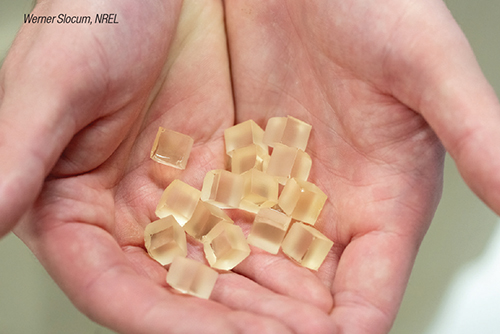As wind energy takes a prominent role in the energy transition, researchers at the U.S. Department of Energy’s National Renewable Energy Laboratory (NREL: www.nrel.gov) have focused on manufacturing sustainable turbine blades that can be made from bio-derivable resources and then chemically recycled at the end of their useful life. The researchers demonstrated the development with a 9-m-long blade made from a biomass-derivable resin named PECAN (PolyEster Covalently Adaptable Network; photo) that was developed by the NREL using bio-derivable sugars.

The findings are published in the journal Science. Nic Rorrer, one of the two corresponding authors of the Science paper, said one of the concerns raised in the literature about these types of materials is that the blade would be subject to greater “creep,” which is when the blade loses its shape and deforms over time. The testing at NREL showed recyclable materials can be used. Composites made from the PECAN resin held their shape, withstood accelerated weatherization validation, and could be made within a timeframe similar to the existing cure cycle that is currently used in wind-turbine manufacturing. While wind blades can measure the length of a football field, the size of the prototype provided proof of the process.
Under existing technology, wind blades last about 20 years, and afterward they can be mechanically recycled and shredded for use as concrete filler, for example. PECAN marks a leap forward because of the ability to recycle the blades using mild chemical processes. Ryan Clarke, a postdoctoral researcher at NREL and first author of the new paper said the chemical process was able to completely break down the prototype blade in six hours.
The U.S. Department of Energy jointly funded the research through its Advanced Materials and Manufacturing Technologies Office and Bioenergy Technologies Office and their support of the BOTTLE Consortium. Additional research and funding will allow the NREL investigators to build larger blades and to explore more bio-derived formulations.